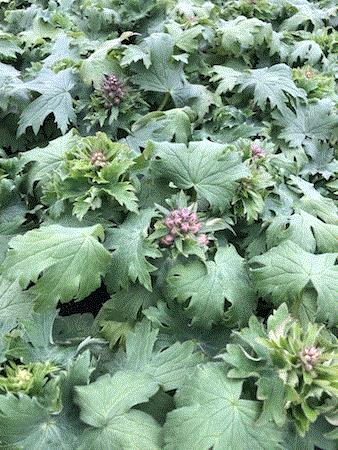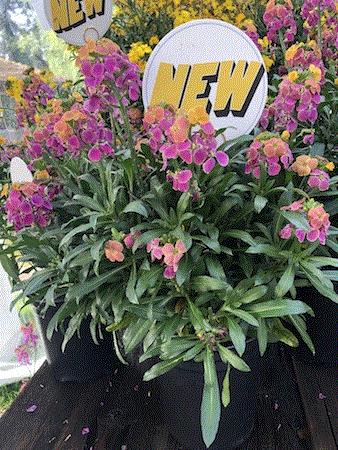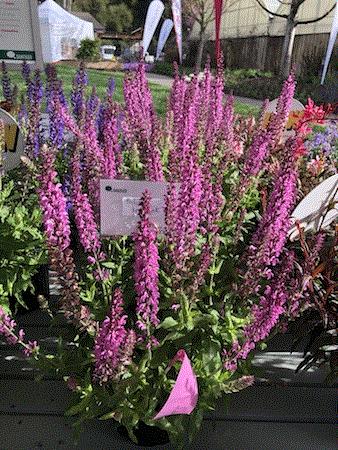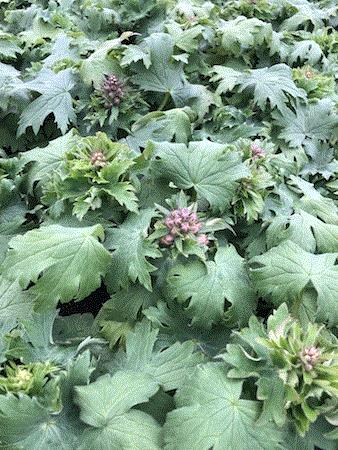Dwarf Upright Delphinium?

Each spring, I come across one or more growers with Delphinium elatum cultivars that appear like the plants shown above. Clearly, something's out of whack. After all, most Delphinium elatum cultivars reach 36- to 48-in. tall when in full bloom. Why do these plants appear stunted? Did they initiate flowers too early? Is a pest or disease holding them back? What about nutrition? What else would cause this? I think you already know the answer ...
The time has come for me to ask, "What's happening here?" Enjoy the upcoming articles and look for the answer to this delphinium dilemma near the end of the newsletter. There's still time to ponder the possibilities. Good luck!
More Perennials from Spring Trials
Yes, the coverage of the California Spring Trials continues. Here's the third installment, showing some of the exciting new perennials I observed at the trials in late March.
Erysimum Erysistible Compact Tricolor

Here's a great spring flowering erysimum I saw at Syngenta Flowers. Erysistible Compact Tricolor has bright bold colors and lots of flower power that's highly noticeable in retail displays. I'm told it's hardy to Zone 5, which opens the door to more growers, retailers and landscapers. Erysistible Compact Tricolor is well branched, grows 18-in. tall and blooms from early to late spring. Looking for an impactful spring flowering perennial? Give Erysistible Compact Tricolor a try.
Thalictrum Nimbus Pink
Nowadays it seems like the majority of new perennial introductions are compact, but occasionally, a refreshing new plant comes along that bucks the trend. After all, we still need great plants for the back of the landscape. Thalictrum Nimbus Pink from Terra Nova Nurseries is a great upright, clumping perennial. Nimbus Pink reaches 28-in. tall when blooming. It has striking dark stems and attractive, showy fern-like foliage. It produces massive puffs of lavender pink flowers in the late spring and early summer to top it off. Hardy to Zone 5.
Salvia Apex Pink

Apex Pink is a new compact salvia from Danziger. This is a first-year flowering perennial that flowers early and uniformly without vernalization. Of course, it can be grown and overwintered like salvias typically are, but it can easily be grown into bloom during the first growing season. Apex Pink is well branched, has short, narrow foliage and produces an abundance of pink inflorescences. Hardy to Zone 4.

Terra Nova & Danziger's North American Licensing Agreement
As you can see above, Terra Nova Nurseries and Danziger both have some great perennials in their offerings. Terra Nova Nurseries (a leader in perennial plant breeding and genetics) has signed a licensing agreement with Danziger (a global leader in bedding plant and cut flower breeding and production) granting Danziger rights to produce and sell cuttings from Terra Nova Nurseries' elite stock. The stock plants will be grown at Danziger's Guatemala facility.
Cuttings of Terra Nova's varieties will be available to all broker companies in North America around Week 40 later this year. Availabilities will be visible through Danziger's ordering system. The perennials will be marketed under the ThinkPlants umbrella, of which both companies are active members.
Summer Events
I know what you're thinking: spring just got here and you'd like to enjoy it for a while before even thinking about the summer. But there are several trade events that are worth attending and might fit your travel plans this summer. Here are a few of them:
Cultivate'19

Mark July 13-16, 2019 on your calendars. This is when Cultivate'19 will be held at the Greater Columbus Convention center in Columbus, Ohio. Cultivate is one of our industry's largest and most-attended events. Cultivate'19 provides four days of educational and networking opportunities. Over 650 exhibitors will have their products and services on display on the massive eight acres of trade show space. Visit http://www.cultivate19.org for event and registration information.
PPA National Symposium

Since you're reading this perennial newsletter, I'm guessing an event devoted entirely to perennials might just be right up your alley. If so, I highly recommend the 2019 Perennial Plant Association's National Symposium July 28 to August 2, 2019 in Chicago, Illinois. The PPA will be hosting the symposium in conjunction with All-America Selections and the National Garden Bureau.
With over 570 parks and public gardens covering 7,600 acres, Chicago's motto is "Urbs in Horto" (city in a garden). There are several great tours scheduled over the course of the symposium: Wisconsin Wonders Tour; Prairie State Tour; North Shore Design Tour; West Design and Retail Tour; Chicago Botanic Garden & City Tour; Chicago Gardens with Purpose Tour; Taste of Chicago Grower Tour; Michigan Marvels Tour; and South by Southwest Design Tour.
There are also two full days of seminars from industry experts, including a keynote presentation from the influential Dutch garden designer and leading figure of the “New Perennial” movement, Piet Oudolf.
If you'd like to attend a perennial-focused trade event, this one is for you.
Click here for event information.
The Farwest Show

Attend the best trade event in the Pacific Northwest August 21 to 23, 2019 in Portland, Oregon. Over 5,000 attendees—including growers, garden centers, buyers, suppliers, landscape professionals and nurseryman—attend the Farwest Show each year to obtain ideas on how to increase efficiency, sales and profitability. Visit over 400 exhibitors on the trade show floor, check out the New Varieties Showcase, the Grower Trends Showcase, take a tour, and attend one or more of the 49 seminars, including the keynote presentation from Chief Economist for American Hort, Dr. Charlie Hall.
As you can see, there's plenty of educational and networking opportunities. It's a beautiful region to visit if your schedule will allow a few additional vacation days. Visit https://farwestshow.com/ for complete event information.

The Answer is ...

At the top of the newsletter, I showed the image above and challenged you to figure out what was happening to those poor dwarf delphiniums. To show that this isn't just a random container that's been dwarfed, here's an image showing a larger portion of a crop with the same symptoms:

By now, I'm guessing most of you narrowed down your choices. If you answered an overdose from plant growth regulators are causing the plants to appear dwarfed or stunted, then you earned yourself a gold star.
In the cases shown here, paclobutrazol (Bonzi, Piccolo, Pac O) drench applications were applied to the delphinium early in the crop cycle. Between the early application and the rate applied (the amount of active ingredient applied per individual container), the plants exhibited an overly strong response. When this occurs, the plants often remain very small, appear stunted and often the flower stalk remains small and close to the foliage.
In many instances, applications of gibberellic acid can be applied to overcome this over growth regulation. I've found spray applications of Fascination or Fresco using 10 to 20 ppm or higher volume sprench applications of 5 ppm to be effective at overcoming PGR overdoses on delphinium.

Obtaining Appropriate Height Control
I can't deny the need the benefits of using PGRs on Delphinium elatum cultivars. How can PGRs be used to obtain a reasonable, but not excessive amount of height control? First off, growers must have realistic expectations—you want to obtain a reasonable amount of height reduction without having much, if any, residual activity. This varies from plant to plant, but a good guideline is to aim for no more than a 25% reduction in plant size. For a delphinium that grows 36-in. tall, a 25% reduction would be 9 in.
Achieving more height reduction than this will often lead to too much persistence in the landscape. You don't want to turn an ornamental grass into turf grass. The plant should still look the way it's supposed to—only slightly shorter. The PGR effect should be short term. This means that although the plant may remain slightly smaller, it should resume its normal rate of growth within a few weeks of the application.
My approach on delphinium is to use spray applications as needed to reduce the size of the lower foliage (one or two applications) early in the crop. I prefer the tank mix of 2,500 ppm daminozide (B-Nine, Dazide) plus 5 ppm uniconazole (Sumagic, Concise) to control plant size early in the crop. Avoid applying drenches or being overly aggressive with spray applications too early in the production cycle.
Once the plants begin to push the flower stems from the base of the plant, but before they break through the canopy, is the next and most important time to use PGRs on delphinium. Spray applications can be applied again at this stage.
Many growers also apply paclobutrazol (Bonzi, Piccolo, Pac O) drenches at this time. The drench rates will vary widely from grower to grower based on the amount of bark (if any) in the growing mix, the size of the container and the amount of solution being applied per container. In general, paclobutrazol drench rates range from 2 to 4 ppm in peat mixes to 6 to 10 ppm in bark mixes.
Remember, the volume of solution applied affects the amount of active ingredient being delivered to each container, which influences the amount of height control that will be obtained.




Thanks for reading this edition of Perennial Pulse. Feel free to drop me a line with any questions or article ideas you may have. You can also send me a quick "hello" anytime. I'd love to hear from you.
My email is ppilon@ballpublishing.com.
Take care,
Paul Pilon
Editor-at-Large
Perennial Pulse
This email was received by you and over 34,113 subscribers!
If you're interested in advertising in Perennial Pulse, contact Kim Brown ASAP and she'll hook you up.